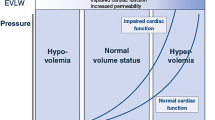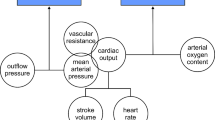Abstract
An accurate assessment of cardiovascular performance is essential to predict and evaluate hemodynamic response to interventions. The objective of this prospective study was to assess whether point-of-care ultrasonography of the common carotid artery (CCA) can estimate the stroke volume (SV) and cardiac index (Ci) of critically ill children. Participants underwent Doppler ultrasonography of the left CCA and transthoracic echocardiography (TTE). Variables measured by TTE were SV and Ci. Carotid blood flow (CBF) was calculated based on both systolic velocity–time integral (CBF(s)) and total velocity–time integral (CBF(t)). Carotid corrected flow time(CFT)was also determined. A total of 50 children were enrolled. The median age and weight of participants were 36.0 months and 14.2 kg, respectively. Both CBF(s) and CBF(t) correlated very strongly with SV (ρ = 0.98 and 0.97, respectively) and Ci (ρ = 0.96 and 0.92, respectively). Agreement analysis showed low biases and clinically acceptable percentage errors between variables measured by TTE (SV and Ci) and those estimated by Doppler ultrasonography. Linear regression analysis revealed that the Ci of mechanically ventilated children can be estimated by the following equation: \({\text{Ci}} = 0.703 + \frac{{6.479\, \times \,{\text{CBF}}_{\left( s \right)}\, \times\, {\text{heart rate}}}}{{\text{body surface area}}}\). CFT did not significantly correlate with SV or Ci (ρ = 0.27 and 0.05, respectively). Doppler ultrasonography of the left CCA is able to estimate the SV and Ci of critically ill children. Therefore, the CDU may be considered as an alternative for estimating Ci in critically ill children when TTE is not feasible or available.



Similar content being viewed by others
Data Availability
The data that support the findings of this study are available from the corresponding author, upon reasonable request.
Code Availability
N/A.
Abbreviations
- CDU:
-
Carotid Doppler ultrasonography
- CCA:
-
Common carotid artery
- CI:
-
Cardiac index
- CI:
-
Confidence interval
- CBF( s ) :
-
Systolic carotid blood flow
- CBF( t ) :
-
Total carotid blood flow
- CBFi( s ) :
-
Systolic carotid blood flow index
- CBFi( t ) :
-
Total carotid blood flow index
- CFT:
-
Carotid-corrected flow time
- CO:
-
Cardiac output
- CoV:
-
Coefficient of variation
- Da:
-
Aortic diameter
- Dc:
-
Carotid diameter
- eCi:
-
Estimated cardiac index
- eSV:
-
Estimated stroke volume
- IQR:
-
Interquartile range
- PICU:
-
Pediatric intensive care unit
- POCUS:
-
Point-of-care ultrasonography
- SD:
-
Standard deviation
- SV:
-
Stroke volume
- SVRI:
-
Systemic vascular resistance index
- TTE:
-
Transthoracic Echocardiography
- VTIa:
-
Aortic velocity–time integral
- VTI( s ) :
-
Systolic velocity–time integral
- VTI( t ) :
-
Total velocity–time integral
References
Alobaidi R, Morgan C, Basu RK et al (2018) Association between fluid balance and outcomes in critically ill children: a systematic review and meta-analysis. JAMA Pediatr 172:257–268. https://doi.org/10.1001/jamapediatrics.2017.4540
Razavi A, Newth CJL, Khemani RG et al (2017) Cardiac output and systemic vascular resistance: clinical assessment compared with a noninvasive objective measurement in children with shock. J Crit Care 39:6–10. https://doi.org/10.1016/j.jcrc.2016.12.018
Gan H, Cannesson M, Chandler JR et al (2013) Predicting fluid responsiveness in children: a systematic review. Anesth Analg 117:1380–1392. https://doi.org/10.1213/ANE.0b013e3182a9557e
Ramsingh D, Alexander B, Cannesson M (2013) Clinical review: does it matter which hemodynamic monitoring system is used? Crit Care 17:208. https://doi.org/10.1186/cc11814
van Wijk JJ, Weber F, Stolker RJ et al (2020) Current state of noninvasive, continuous monitoring modalities in pediatric anesthesiology. Curr Opin Anesthesiol 33:781
Suehiro K, Joosten A, Murphy LS-L et al (2016) Accuracy and precision of minimally-invasive cardiac output monitoring in children: a systematic review and meta-analysis. J Clin Monit Comput 30:603–620. https://doi.org/10.1007/s10877-015-9757-9
De Souza TH, Brandão MB, Nadal JAH et al (2018) Ultrasound guidance for pediatric central venous catheterization: a meta-analysis. Pediatrics 142:e20181719. https://doi.org/10.1542/peds.2018-1719
Bland JM, Altman DG (1999) Measuring agreement in method comparison studies. Stat Methods Med Res 8:135–160. https://doi.org/10.1177/096228029900800204
Chew MS, Poelaert J (2003) Accuracy and repeatability of pediatric cardiac output measurement using Doppler: 20-year review of the literature. Intensive Care Med 29:1889–1894. https://doi.org/10.1007/s00134-003-1967-9
Bonett DG, Wright TA (2000) Sample size requirements for estimating pearson, kendall and spearman correlations. Psychometrika 65:23–28. https://doi.org/10.1007/BF02294183
Gaspar HA, Morhy SS, Lianza AC et al (2014) Focused cardiac ultrasound: a training course for pediatric intensivists and emergency physicians. BMC Med Educ 14:25. https://doi.org/10.1186/1472-6920-14-25
Peng Q-Y, Zhang L-N, Ai M-L et al (2017) Common carotid artery sonography versus transthoracic echocardiography for cardiac output measurements in intensive care unit patients. J Ultrasound Med 36:1793–1799. https://doi.org/10.1002/jum.14214
Sidor M, Premachandra L, Hanna B et al (2018) Carotid flow as a surrogate for cardiac output measurement in hemodynamically stable participants. J Intensive Care Med. https://doi.org/10.1177/0885066618775694
Roehrig C, Govier M, Robinson J et al (2017) Carotid Doppler flowmetry correlates poorly with thermodilution cardiac output following cardiac surgery. Acta Anaesthesiol Scand 61:31–38. https://doi.org/10.1111/aas.12822
Gassner M, Killu K, Bauman Z et al (2015) Feasibility of common carotid artery point of care ultrasound in cardiac output measurements compared to invasive methods. J Ultrasound 18:127–133. https://doi.org/10.1007/s40477-014-0139-9
Ma IWY, Caplin JD, Azad A et al (2017) Correlation of carotid blood flow and corrected carotid flow time with invasive cardiac output measurements. Crit Ultrasound J 9:10. https://doi.org/10.1186/s13089-017-0065-0
Nusmeier A, van der Hoeven JG, Lemson J (2010) Cardiac output monitoring in pediatric patients. Expert Rev Med Devices 7:503–517. https://doi.org/10.1586/erd.10.19
Beier L, Davis J, Esener D et al (2020) Carotid ultrasound to predict fluid responsiveness. J Ultrasound Med 39:1965–1976. https://doi.org/10.1002/jum.15301
Kim D-H, Shin S, Kim N et al (2018) Carotid ultrasound measurements for assessing fluid responsiveness in spontaneously breathing patients: corrected flow time and respirophasic variation in blood flow peak velocity. Br J Anaesth 121:541–549. https://doi.org/10.1016/j.bja.2017.12.047
Barjaktarevic I, Toppen WE, Hu S et al (2018) Ultrasound assessment of the change in carotid corrected flow time in fluid responsiveness in undifferentiated shock. Crit Care Med 46:e1040
Acknowledgements
Thanks to Carolina Grotta Ramos Telio for her review of the article. We also thank the nursing, technical staff, and the pediatric intensive care residents.
Funding
No external funding for this manuscript.
Author information
Authors and Affiliations
Contributions
AJR and LLdS: responsible for data collection, drafting and critical revision of the manuscript. RJNN and MBB: responsible for critical revision of the manuscript for important intellectual content. THdS: responsible for the study concept and design, acquisition, analysis and interpretation of data.
Corresponding author
Ethics declarations
Conflict of interest
The authors have no conflicts of interest relevant to this study to disclose.
Ethical Approval
The study was approved by the local institutional review board (UNICAMP’s Research and Ethics Committee, Approval Number 31665420.9.0000.5404).
Consent to Participate
Written informed consent was obtained from the participants’ legal guardian.
Consent for Publication
N/A.
Additional information
Publisher's Note
Springer Nature remains neutral with regard to jurisdictional claims in published maps and institutional affiliations.
Rights and permissions
About this article
Cite this article
Rubio, A.J., de Souza, L.L., Nogueira, R.J.N. et al. Carotid Doppler Ultrasonography for Hemodynamic Assessment in Critically Ill Children. Pediatr Cardiol 43, 382–390 (2022). https://doi.org/10.1007/s00246-021-02732-9
Received:
Accepted:
Published:
Issue Date:
DOI: https://doi.org/10.1007/s00246-021-02732-9




